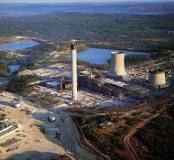This what the decline of base-load and centralised generation looks like. Stanwell Corp, the Queensland government owned electricity generator, has failed to make any money in the past year from its 4,000MW of coal and gas fired generation because rooftop solar has taken away demand and pushed down wholesale electricity prices.
The owner of nearly half the state’s centralised generators returned a profit of just $14 million in the last financial year, as it closed down one sixth of its capacity and watched the remainder sit idle for long periods.
Its core business of generation actually operated at a loss, and the company only made a profit because of revenue from unused coal that it sold overseas. It said the price falls caused by the proliferation of solar and changing consumption patterns meant its business was not sustainable.
The biggest cause of this falling demand was the proliferation of solar PV, which has grown from 5MW in 2009 to 860MW in 2013. “Faced with increases in retail electricity costs, consumers are reducing their consumption or installing solar photovoltaic panels,” CEO Richard Van Breda noted in the annual report.
However, the annual report also reveals large structural faults in the industry, and the legacy of massive over-building of capacity. Van Breda said that the Queensland electricity market had 60 per cent more capacity than it needed to meet average demand.
Some surplus is required in any grid to meet peak demand and to have reserve capacity, but the extent of the excess capacity reveals the extent to which the government and private interests overbuilt, and cannot be blamed on the popularity of solar PV alone
Nevertheless, the Stanwell CEO had a spray against solar PV, the “heavily subsidised” renewable energy, and the carbon tax. He said the energy demands from the giant LNG plants being built in the state’s north would need at least 100MW of generation and represented the best opportunity for a “resurgence” in coal fired generation.
Stanwell did not expand on its characterisation of “heavily subsidised” renewable energy. But it seems to run counter to the fact that Queensland households, but its own admission, are installing solar as a hedge against rising electricity prices, even with subsidies largely removed.
And it is ironic given that the government provides a $600 million subsidy to the cost of delivering the state’s largely fossil fuel generation to regional users. And, apart from rooftop solar, there is virtually no renewable generation in the state apart from some bagasse and some hydro.
Stanwell said it is looking forward to the removal of the carbon tax, which it said cost $355 million in its first year (state owned black coal generators did not get compensation).
A year ago, it said it expected a $400 million carbon tax bill and said it was well positioned to meet that cost. This year it said: “All of these factors have resulted in wholesale electricity prices that continue to fall short of achieving an adequate long-term return on the business. “
And it doesn’t look like the company will evolve anytime soon. In its performance review, under the heading “diversifying its energy revenue mix”, it talks of boosting exports of coal. Under the heading “Renew the plant and fuel portfolio for the future”, it talks of how to exploit the Kunioon coal resource
The table below indicates the problems the generator has faced in the past year. No plant ran at more than 67 per cent capacity, and that was achieved at Tarong only after the closure of one half of its capacity. Output at the Swanbank E combined cycle gas generator was down by one third as its capacity fell to less than 43 per cent.. Interestingly, Stanwell was unable to meet the minimum required 89.3 per cent availability. Tarong was unavailable 15.2 per cent of the time, and only one third of these outages was planned.
The whole Tarong facility sent out 15 per cent less output than it did in the previous year, when Stanwell noted that there was an average surplus of 4,500MW in capacity during 2011/12 That was another way of saying that its entire portfolio was virtually surplus to requirements, and the fall in demand since then, and the growth in solar PV suggests that that problem has only gotten worse.
In late 2012, it put two generation units with a capacity of 700MW at Tarong Power Station in “cold storage”. It said this decision was in response to the excess capacity, and at the time of the decision it just happened to match the amount of solar capacity.
Stanwell said the past year had been the most difficult since the inception of the National Electricity Market in 1997, and the next two years would also be difficult.But it was hopeful it could generate returns of 8-10 per cent in it coal and gas fired generation business by 2017/18. The government that owns the company, and may want to sell its generation capacity, has argued strongly for the renewable energy target to be discontinued.







